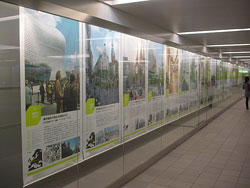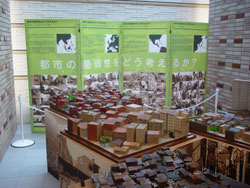|
The Center for Sustainable Urban Regeneration (cSUR) is a thinktank established at the University of Tokyo in 2003. Recognizing that the issues facing contemporary architecture and cities require a cross-disciplinary approach, cSUR is an ambitious, ongoing experiment in integrating the disciplines of urban planning, architecture, civil engineering, and environmental engineering. The work being produced by cSUR is a combination of empirical research and innovative design proposals, all aimed at producing new knowledge and techniques for sustainable urban regeneration. Over the last four years, cSUR has been steadily expanding into a worldwide network of researchers and practitioners, and currently comprises a group of more than one hundred academics, led by Professor Shinichiro Ohgaki of the Graduate School of Engineering at the University of Tokyo.
The Center has been busy during its brief existence, building networks with other institutions, doing fieldwork in cities throughout the world, and organizing student workshops to produce concrete proposals. Following publication of a series of in-depth bilingual booklets on each major topic of their research so far, the work has now been assembled into a fascinating exhibition that examines fifty cities from across the globe, comprising material that ranges from statistical data to personal anecdotes.
 |
 |
 |
| "Reorganization of Places" corner exhibit, presenting examples that include Birmingham and Copenhagen. |
"Vulnerable Urban Areas" such as Medellin and Bangkok explained using panels and models. |
The exhibition was installed for a period of two weeks in an underground train concourse in Tokyo, part of the complex web of spaces focused on Tokyo Station; a 180m-long corridor was temporarily transformed into a dynamic gallery space with a guaranteed audience. Display panels wrapped the full circumference of the existing cylindrical columns: for commuters walking in one direction, they appeared to be an array of green-colored graphics with maps and texts, while those walking in the opposite direction saw black-and-white photos of urban scenes. Other panels lined the perimeter walls of the concourse, containing color images of successful urban regeneration projects from around the world. The wall-mounted showcases normally used for advertising displays had also been annexed for the exhibition. Small models on cubic plinths showed the comparative densities, heights, and forms of urban residential districts from various cities, primarily those in developing countries. An array of video monitors displayed interviews with international architects, and a set of benches colored in the distinctive cSUR green provided audience seating for a small symposium held partway through the exhibition period -- all in all, a successful and surprising adaptation of an ordinary urban circulation space.
Although the participants are from all over the world, the chosen cities are mostly located in Asia and, to a lesser extent, South America. Indeed, as is well known, these are the regions where the megacities of the immediate future are fermenting, and where the practical environmental problems are most urgent: water supply, waste management, flood control, mass housing, public transportation, infrastructure maintenance, and the conservation of historical heritage. To cSUR's credit, they are clearly not looking for generic solutions or slogans. The problems may ultimately affect us all, but the exhibition shows that the techniques for dealing with them will inevitably be site-specific. This kind of painstaking fieldwork is the essential first step.
|